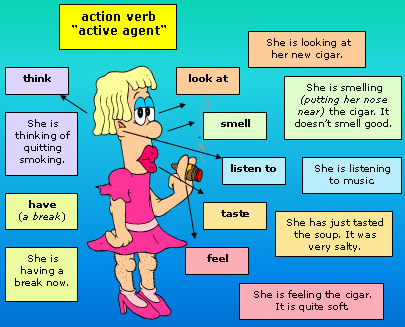คำกริยาในภาษาอังกฤษมีเย๊อะแยะมากมาย เรารู้กันดีอยู่แล้วว่ากริยาคือคำที่แสดงการกระทำ แค่กริยาอย่างเดียวก็ถูกแบ่งเป็นกลุ่มได้หลายแบบ ในที่นี้จะแบ่งออกเป็น 2 กลุ่ม คือ
- Action verb
- Stative verb
1. action verb

หรือ บางคนเค้าก็เรียกว่า dynamic verb คือคำกริยาที่แสดงอาการ การกระทำ มีการขยับเขยื้อน เคลื่อนไหว พูดง่ายๆคือ เรานึกภาพออกว่าเขาทำกริยานั้นๆอย่างไร เช่น ถ้าบอกว่า เขากินข้าว เราก็นึกภาพออกว่าเขากำลังตักข้าวเข้าปาก หรือ เขากระโดด เราก็เห็นภาพคนกำลังกระโดด ที่มันได้ชื่อเก๋ๆมาอีกชื่อหนึ่งว่า dynamic verb เพราะคำว่า dynamic มันแปลว่า เคลื่อนไหว ไงล่ะคะ กริยากลุ่มนี้มีเยอะแยะ มากมาย ส่วนใหญ่ก็เป็นกริยาที่เราเรียนมากันตั้งแต่ประถมนั่นแหละค่ะ เช่น eat, drink, speak, write, catch, go, walk, watch, sit, hit, sleep, hold, etc. นี่แค่ตัวอย่างเพื่อให้เห็นภาพของ action verb เท่านั้นค่ะ
2. stative verb
หรือบางครั้งเรียกว่า state verb หรือ abstract verb คือคำกริยาที่ไม่ได้แสดงการกระทำหรือการเคลื่อนไหว แต่เป็นกริยาที่แสดงสภาวะ คำกริยาที่จัดอยู่ในกลุ่ม stative verb แบ่งออกเป็น 6 ประเภทดังนี้ค่ะ
2.1 คำกริยาที่แสดงการรับรู้ แสดงถึงการใช้ประสาทสัมผัส ดู ได้ยิน ได้กลิ่น ลิ้มรส รู้สึก คือ hear, see, smell, taste, feel ตัวอย่างประโยค เช่น
- The roast chicken smells good. ไก่ย่างกลิ่นหอมจัง
- I heard someone crying outside. ฉันได้ยินใครบางคนร้องไห้อยู่ข้างนอก
2.2 คำกริยาที่แสดงสภาวะทางความคิด เช่น believe, know, recognize, think, doubt, mean, remember, understand, forget, realize, suppose, etc.
- I don’t know Jason, so I won’t invite him to my birthday party.
- I recognized you as soon as you come into the room.
2.3 คำกริยาที่แสดงความเป็นเจ้าของ เช่นbelong, own, have, possess
- That is the only valuable thing I possess. นั่นเป็นสิ่งมีค่าชิ้นเดียวที่ฉันมี
- I don’t have any money left. ฉันไม่มีเงินเหลืออยู่เลย
2.4 คำกริยาแสดงอารมณ์หรือความรู้สึก เช่นlove, like, hate, mind, envy, wish, prefer, fear, surprise, astonish, etc.
- I like her style.
- I prefer tea to cake.
2.5 คำที่แสดงการวัดหรือการประมาณค่า เช่น weigh, cost, measure, contain, equal, etc.
- This pack of sugar weighs more than that one. น้ำตาลถุงนี้หนักมากกว่าถุงนั้น
- The ring costs 23,000 baht. แหวนวงนี้ราคา 23,000 บาท
2.6 คำกริยาแสดงสภาวะอื่นๆ เช่นverb to be (is, am, are), owe, seem, exist, require, etc.
- I owe you a lot. ฉันเป็นหนี้คุณมากมายเหลือเกิน
- It seems that you don’t understand me. ดูเหมือนว่าเธอจะไม่เข้าใจฉัน
*** stative verb บางคำเป็นได้ทั้ง action verb และ stative verb ดังนั้นในการนำไปใช้จะต้องแยกนิดนึงว่า เป็นแบบไหนเพราะถ้าเป็นแบบ stative verb จะเอามาทำเป็น continuous tense หรือกริยารูปกำลังกระทำไม่ได้ เช่น
- The cake tastes delicious. (stative verb) เค้กมีรสอร่อย
(เราจะไม่พูดว่า The cake is tasting delicious. แปลว่า เค้กกำลังมีรสอร่อย แบบนี้ผิดค่ะ ) - I’m tasting the soup. Let’s see if it’s too much salty. (action verb)
ฉันกำลังจะชิมซุปถ้วยนี้ ดูสิว่าจะเค็มไปมั้ย
เมื่อแยกความแตกต่างระหว่าง stative verb และ action verb ได้แล้วก็ระมัดระวังเวลาใช้ด้วยนะคะ ^^


